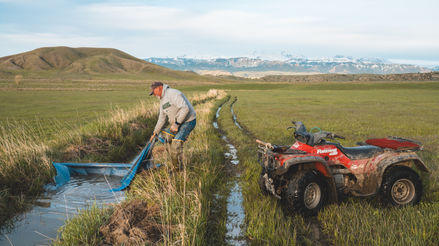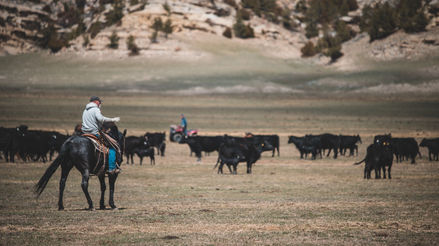

Ranching
With agriculture contributing only two percent to Wyoming's GDP, ranching no longer plays much of an economic role in Wyoming. Nevertheless, ranching, which existed in this region as early as the 1860s, continues to have a great influence on the cultural identity, self-perception and way of life of many people in this state. Not without reason, Wyoming calls itself the "Cowboy State" to this day. Even beyond Wyoming, the myth of the cowboy - who stands for freedom and self-sufficiency and is therefore strongly associated with American conservatism - has had a significant influence. Through literature, film and other arts, this myth has been carried forward to the present day and continues to shape the image of the USA.
But what is it like to work on a ranch today? What jobs have to be done and what role do cowboys play today at all ? The following photographs and texts provide an impression about ranching in Wyoming today.
Pairing and Tagging
On the ranch where I conducted my research, the cattle spend the calving season in so-called feedlots, where they are provided with hay and water on a daily basis. The first calves are born at the end of February. When they are about a day or two old, workers herd them out of the feed lots together with their mothers. In a separate pen, the calves are ear-tagged and given a vitamin injection. The male calves also have a rubber ring put over their testicles so that they die off after a few weeks. The animals are then released to the pastures, where the calves are kept with their mothers until shipping day. On other ranches, the animals also spend calving season on the pastures, which makes pairing and tagging very time-consuming, but the animals can roam around, which is more natural.
The cold weather at this time of year and diseases can affect the herd, causing some of the weaker animals to die. At the same time, the first grizzly bears awake from hibernation and hungrily roam the area. Grizzlies are usually satisfied with the remains of animals that have already died. However, if a wild animal is suspected of having killed a calf, a Game & Fish employee has to come and check the animal for fatal injuries. Only then can the rancher apply for compensation.
Brandings
During brandings, the calves born in spring are marked with the ranch's brand. Branding is required by law in Wyoming, and each ranch has its own brand so the animal can be clearly identified should it ever be lost. Brandings are also an important social event where neighboring ranches and other members of the community come together to help with the tedious and physically demanding work. Community help is even more important because many ranches - due to time and cost factors - no longer have any horses of their own. Much emphasis is placed on tradition at brandings and so the cowboy or, in rarer cases, the cowgirl plays an important role here. The riders, who are often dressed in a particularly traditional way on this day, are responsible for roping the calves and dragging them to the helpers, where they receive their branding. The brandings take place in designated pens, where the animals are herded before. After the work is done, the host ranch invites for dinner and the experiences of the day are discussed.
Farming
The hay needed to feed the animals during the winter months is grown by most ranches on their own. It is often a mixture of different grasses as well as alfalfa, a very nutritious forage plant. Because Wyoming receives very little rainfall - just 5 to 7 inches here in the very dry Big Horn Basin - the fields must be continuously irrigated. Consequently, cultivation can only take place near larger water supplies, such as rivers or reservoirs. Various irrigation techniques are used. Among them are large so-called center pivots, whose sprinkler systems move in a circle around a center on wheels and can nowadays be controlled remotely via an app. Another technique is wheel line irrigation. This sprinkler system, which is mounted on large wheels, can be moved across the field with the help of an engine. It is much more flexible than center pivots and can also be used in non-circular fields with obstacles such as trees or buildings. The most labor-intensive technique is flood irrigation. Fields irrigated in this way are crisscrossed by small ditches that are manually dammed with foliage at various points. The fields are arranged on a slight slope so that the water from the horizontally running dammed ditches slowly floods the lower part of the field. Despite the intensive irrigation, there is usually only one mowing per year due to the short growing season.
Cattle Drives
Cattle drives take place mainly in the summer months and in the fall. On the one hand, the cattle are driven from pasture to pasture to avoid overgrazing, on the other hand, they have to be driven into corrals several times a year to be branded, medically treated or sold. In the past this work was used to be done exclusively on horseback, but nowadays so-called all-terrain vehicles (ATVs) are often used too. Quads, buggies or motorbikes save a lot of time and money. Still, some jobs that can only be carried out on horseback remain. Many pastures where the cattle spend summer and fall are partly crisscrossed by canyons and rugged slopes where no ATV can reach, no matter how off-road capable it may be. Consequently, horses remain the only way to follow the cattle there. However, many simply do not want to do without horses and carry out the work on horseback to maintain the tradition. Therefore, horses and ATVs are often used simultaneously, profitably combining the advantages of the different means of transport.
Shipping
Shipping Day is a crucial moment for ranchers as it marks the culmination of their efforts throughout the year. On this day, the calves born in spring are carefully sorted by sex and weighed in small groups on a cattle scale. This allows for the determination of the total sale price, as well as giving buyers a glimpse into the overall condition of the animals. Any individuals that may be too small or young can be sorted out at this time. The animals are then loaded onto large trucks and transported to “feedyards”, where they will be fattened for an additional two years. As cattle are sold by weight, it is important for ranchers to choose the optimal time to ship them. Selling them too early results in lower revenue due to their lower weight, while selling them too late can lead to increased costs and overuse of pastures. Additionally, the changing weather conditions of this time of year can also have a detrimental effect on the health and body weight of the animals.
Preg-Checking
Pregnancy checking is a process that takes place on a ranch towards the end of the year. As the name suggests, the cows are checked for pregnancies. The herd needs to be brought in from the pasture to be individually examined in a squeeze chute. The veterinarian typically performs the examination by manually palpating the uterus. He or she can also estimate how far along the pregnancy is and when the calf is due. The cows are usually categorized into early, middle and late stages and marked with a bleach marker on their flank. This information is important for the rancher as the goal is to have the calves born in a relatively small time frame, making the work easier and ensuring the calves are equally developed. During this process, cows that are not pregnant or too old are sorted out and later sold. This also applies to cows that would give birth outside of the rancher's designated time frame. Additionally, the animals are dewormed and vaccinated if needed. With herds of several hundred cows, this process is time-consuming and physically demanding, and the weather at this time of year can be harsh.






















